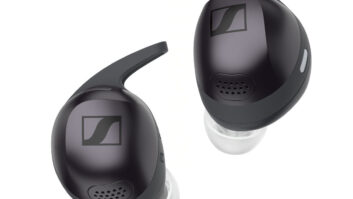LONG BEACH, CALIF. — Mitsubishi Digital Electric America unveiled to dealers here its first five fully integrated HDTV sets that go “beyond HDTV” by incorporating a comprehensive home networking system designed to connect and control digital and analog home theater components through the TV’s menu system.
The TVs equipped with the home networking system, which Mitsubishi calls “NetCommand,” are believed to be the first to bring a practical application of HAVi-enabled digital home networking standards to a home entertainment system.
Mitsubishi’s NetCommand is designed to operate home theater components on two levels. The first centers around the IEEE- 394 digital interface, 5C copy protection (a.k.a. DTCP) and Home Audio Video Interoperability (HAVi) protocols. This will distribute authorized content in digital form and control signals through TV-compatible digital components, including an HDTV-capable D-VHS VCR that Mitsubishi will ship this fall.
The second level, which uses proprietary software developed by Mitsubishi, offers a system of universal IR control codes to enable users to operate various analog and non-1394-compliant home theater components through on-screen menus and virtual control displays. The system will even allow the TV set to help distribute content to, and control equipment in, home theater set-ups placed in remote rooms.
Digital components interconnected with IEEE-1394 cables are controlled via HAVi interoperability software, supplied by Mitsubishi partner VividLogic of Fremont, Calif. Legacy analog products and digital components lacking IEEE-1394 connections can be controlled on-screen using virtual product controls tied to an extensive collection of product IR control codes stored in the television’s memory. After a set-up process, the HDTV sets use IR blaster leads to send IR signals to various components in the system.
Borrowing a phrase from an old Doors song, Max Wasinger, Mitsubishi’s sales and marketing VP, proclaimed the new technology will “break on through to the other side” of the digital future.
Bob Perry, newly appointed market VP, said the NetCommand technology effectively bridges the worlds of analog and video for home networks, and predicted other companies would have to license Mitsubishi’s technology in order to participate in the broadbased approach.
The new integrated sets are offered in three 16:9 screen sizes (55W, 65W and 73W-inches). All models including the NetCommand home entertainment network system, IEEE-1394 digital interfaces with HAVi and 5C, and fully integrated over-the-air DTV decoders with third-generation tuning circuitry.
All of the HDTV sets include IEEE-1394 digital interfaces with 5C copy protection, HAVi and the NetCommand feature. Additionally, all models will simultaneously down convert digital signals to S-Video and composite video outputs for analog recording of digital content from either broadcast or 1394 sources.
The entry-level fully integrated set (model WS-55859) is found in the company’s Platinum Series of HDTV level rear-projection displays. The 55-inch 16:9 HDTV set carries a $4,299 suggested retail price and will ship to dealers this fall. Key features in the Platinum class include: a third-generation DiamondDigital pixel multiplier (DPM3), 5-mode format expansion, film mode (full-frame 3-2 pulldown capability), HD RGB and component video inputs, and two progressive scan inputs.
The WS-65869 is offered in the step-up Platnium Plus HDTV series. Additional features from the Platinum model include QuadField Focus magnet beam control system for sharper corner-to-corner focusing, improved audio system and enhanced cosmetic look. The 65W-inch 16:9 HDTV set will carry a $5,299 suggested retail price when it ships in the fall.
The top-of-line Diamond Series offers three fully integrated models: the WS-55909 (55W-inches, price to be determined), the WS-65909 (65W-inches, price to be determined) and the WS-73909 (73W-inches, $10,499). All are expected in the fall.
The Diamond Series models add anti-glare Diamond shields, VGA computer inputs, gold-plated high-conductivity connectors, two-way stereo speakers, high-gloss cabinetry, and a Tru-Focus lens system.
The integrated models will also include decoding circuitry for QAM digital cable signals, but no point of deployment (POD) smart card slot is offered to descramble non-basic programming, Perry said, because the OpenCable software standard is still unsettled. Unlike other DirecTV partners, Mitsubishi also omitted decoding for DirecTV standard and high-definition TV services because Perry said some of Mitsubishi’s dealers are not authorized DirecTV distributors, and wanted to make the new technology available to all of its authorized dealers, which includes Sears (an authorized EchoStar retailer).
At the same time the integrated sets ship to dealers, Mitsubishi will release its first HDTV-capable D-VHS VCR, as one of the first components for a Mitsubishi’s NetCommand home entertainment network. The digital deck, like the TVs, includes an IEEE-1394 interface, 5C and HAVi protocols. The deck will record off-air DTV broadcasts tuned by one of the new integrated HDTV sets and output via the two-way 1394 interface to the recorder. The D-VHS unit will also recorded non-restricted content output via other IEEE-1394 enabled devices. However, Mitsubishi’s previously released DTV set-top decoder does not include a digital interface connection.
Perry said Mitsubishi opted to release a D-VHS VCR because it realized that it will be years before an HDTV-ready DVD recorder will be on the market. However, he hinted that an external hard-drive recorder might be on the way in the near future.
Mitsubishi decided to drop its home theater audio component products as a conscious attempt to distance the brand from “me-too” products in order to concentrate on technologies that will forge the brand’s reputation as DTV/home networking leader












